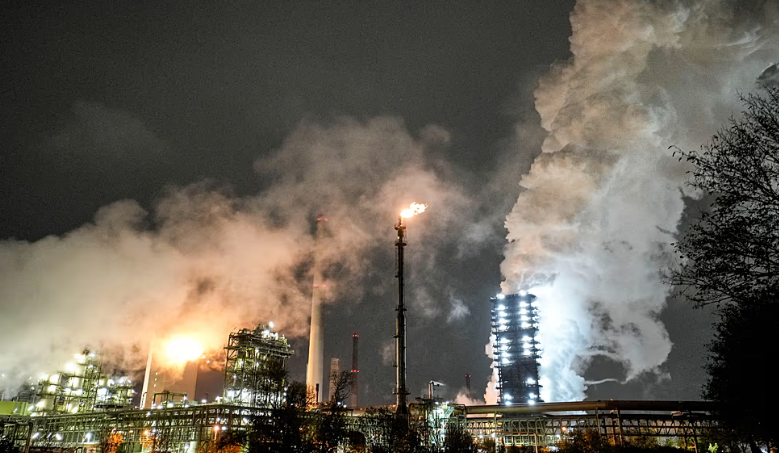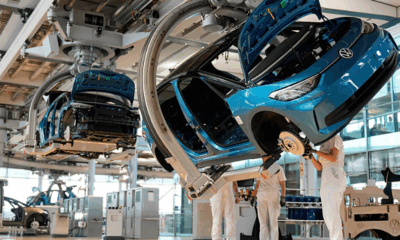Business
Puma Shares Soar on Potential Anta Sports Takeover Interest

German sportswear brand Puma saw its shares rise more than 14% in Frankfurt on Thursday after reports emerged that China’s Anta Sports is exploring a takeover.
Bloomberg News reported that Hong Kong-listed Anta has been working with advisers to evaluate a potential bid for Puma. The company may partner with a private equity firm if it decides to move forward. Other potential suitors mentioned in media reports include Chinese rival Li Ning and Japanese sportswear firms such as Asics.
Li Ning told Euronews that it remains focused on its own brand strategy and has not engaged in any substantive discussions regarding a Puma acquisition. Asics did not immediately respond to requests for comment, while Anta and Puma declined to comment.
The takeover interest comes as Puma navigates a difficult financial period. The German company, which employed around 20,000 full-time staff at the start of 2025, has lost more than three-quarters of its market value over the past five years amid intense competition in the global sportswear sector.
Puma has faced challenges from US tariffs on China and Vietnam, key manufacturing hubs for the brand, which have squeezed profit margins. Analysts have also criticised Puma’s slow response to trends such as the retro trainers craze. Its Palermo and Speedcat shoes lagged behind Adidas’ successful Samba and Gazelle relaunches.
In its third-quarter earnings report, Puma noted that volatile geopolitical and macroeconomic conditions, along with muted brand momentum, shifts in sales channels, elevated inventory levels, and tariff pressures, would continue to weigh on performance for the remainder of 2025.
CEO Arthur Hoeld, appointed in spring as part of a leadership shake-up, has launched a transformation plan aiming to restore growth by 2027. The plan includes reducing Puma’s product range, restructuring its wholesale approach to prioritise direct-to-consumer sales, and cutting 1,400 jobs so far this year, including 900 announced in October.
Despite renewed takeover interest, any acquisition could face resistance from France’s billionaire Pinault family. The family’s holding company, Artémis, owns about 29% of Puma, a stake acquired from Kering in 2018. Earlier this year, Artémis said it was considering all options for the shares.
The potential deal highlights growing interest from Chinese and Asian investors in European sports brands, particularly those struggling to regain market share. For Puma, a takeover could offer a path to financial stability and strategic investment, while raising questions about the future direction of the German brand’s operations and management.
With shares already jumping on the news, market watchers will be closely observing whether Anta or other bidders make a formal offer, and how Artémis responds to any proposal for the significant stake it controls in Puma.
Business
Stellantis and CATL Break Ground on €4.1 Billion EV Battery Plant in Spain

Europe’s second-largest carmaker, Stellantis, and Chinese electric vehicle (EV) battery giant CATL have started construction on a €4.1 billion lithium iron phosphate (LFP) battery factory in northeastern Spain. The joint venture, located in the Aragon region, is expected to create 4,000 jobs and supply EVs across Europe.
The project, first announced last year, marks one of the largest Chinese industrial investments in Spain. At a groundbreaking ceremony on Wednesday, executives highlighted the plant’s strategic role in supporting Europe’s energy transition and industrial modernization.
Andy Wu, CEO of the joint venture, declined to confirm media reports suggesting that up to 2,000 Chinese workers may be involved in construction, stating that final staffing numbers will be determined as subcontractors are selected.
Spanish Minister of Industry, Trade and Tourism Jordi Hereu described the plant as a “strategic milestone” and emphasized the strong collaboration between Spanish and Chinese companies. He said the project underscores Spain’s role in advancing Europe’s electrification goals and strengthening its industrial base.
The facility will operate entirely on renewable energy and is scheduled to begin production by the end of 2026. Once operational, it is expected to produce 50 gigawatt-hours of LFP batteries per year, enough to power tens of thousands of electric vehicles annually.
Spain has maintained a relatively open approach to Chinese investment compared with some other EU nations. Last year, the country generated more than half of its electricity from renewable sources and relies on imported critical raw materials, solar panels, and green technologies to accelerate its shift from fossil fuels.
CATL, the world’s largest EV battery manufacturer, has a growing footprint in Europe. The company already operates a production facility in Erfurt, Germany, which has been active since 2022, and is preparing for full-scale output in Debrecen, Hungary. CATL’s customers include Tesla, BMW, and Volkswagen, and the company continues to expand its influence across the global EV supply chain.
The Chinese firm also invests heavily in large-scale mining projects for lithium, nickel, and cobalt, both in China and abroad, including ventures in Indonesia and Bolivia. These investments provide CATL with significant control over critical materials needed for EV batteries, enhancing its strategic position in the global market.
The Aragon factory is expected to boost Spain’s manufacturing sector, contribute to Europe’s electric mobility ambitions, and strengthen supply chains for critical battery materials. The project represents a significant step for both Stellantis and CATL as they position themselves at the forefront of Europe’s EV transition.
Business
High Electricity Prices Threaten Europe’s Green Transition and Industrial Competitiveness

Rising electricity costs are slowing Europe’s shift to a low-carbon economy and putting key industries at a competitive disadvantage, according to Morningstar’s latest Electrification Observer report.
The European Union has relied on electrification to reduce emissions in sectors such as transport, heating, and heavy industry. Despite generous subsidies and ambitious targets, the pace of adoption remains slow. Europe is on track to electrify just 25% of its energy consumption by 2030, short of the 32% needed to meet climate goals.
“Europe finds itself in a difficult bind,” said Tancrede Fulop, senior equity analyst at Morningstar. “High electricity prices deter adoption of clean technologies. Heat pumps remain unaffordable for many households, while energy-intensive industries such as chemicals and steel lose ground to competitors in the US and China.”
Electricity in Europe is significantly more expensive than in the US and China, a gap widened by post-2021 market turbulence. Morningstar forecasts EU electricity consumption to grow at only 1.1% annually from 2024 to 2030, compared with 1.4% in the US. Network levies and taxes are expected to keep prices high, reducing incentives for households and industry to switch to cleaner energy.
The report highlights heat pump deployment as a clear example. Only 39 million units are expected to be installed by 2030, far below the EU target of 60 million. Residential electrification is projected to rise from 26% in 2023 to 28% by 2030, resulting in annual CO₂ reductions of just 1.7%, slower than the previous decade.
Data centres and electric vehicles will contribute only modest gains. Energy consumption by data centres is expected to grow 15% annually, reaching 182 terawatt-hours by 2030. Battery electric vehicles are projected to make up 45% of European auto sales by 2030, but the electrification of transport will cover only 5% of total energy use, reducing CO₂ emissions from road transport by just 5%.
High electricity costs are also affecting the chemical industry, which is expected to contract by 10% over the next five years. Green hydrogen production is forecast at just 0.6 megatonnes by 2030, far below the EU’s 10 Mt target, as power costs make it uncompetitive in most member states.
The report warns that slow electrification could increase political and policy pressure, potentially delaying EU climate measures such as the 2026 phaseout of free industrial carbon allowances and 2027 carbon pricing for residential heating. Under current trends, Europe is projected to reduce emissions by only 43% by 2030, short of the 55% target set for 1990 levels.
Regional differences are emerging. Northern Europe, France, and the Iberian Peninsula benefit from lower power costs and abundant clean energy, attracting data centres and green industrial projects. Other regions face higher costs and slower progress.
Morningstar concludes that Europe risks paying the high price of decarbonisation without achieving its full benefits, trapped in a transition that is both costly and politically sensitive.
Business
Flexible Work Could Boost Employment for Parents, Carers, and Disabled Workers, UK Report Finds

A recent UK parliament report has highlighted the potential of flexible work arrangements to support employment, particularly for parents, carers, and people with disabilities, as the country faces a rise in unemployment. The select committee’s report, titled “Is working from home working?”, examined evidence from experts across sectors to assess how remote and hybrid work affects individuals, businesses, productivity, and workplace dynamics.
The report comes shortly after Office for National Statistics (ONS) figures showed UK unemployment rose to 5% in the three months to September. Policymakers and researchers have suggested that remote and hybrid work could help retain staff while encouraging people who might otherwise be unable to work to re-enter the labour market. One survey respondent cited in the report said, “I gave up my job of 14 years because childcare was too expensive,” illustrating how flexible arrangements could reduce barriers to employment.
Research from Italy was also cited, showing that flexible work enables parents and carers to balance professional and domestic responsibilities more effectively. The report noted that potential gains for disabled employees align with the government’s focus on increasing disability employment.
While the report acknowledged that many roles must be performed in person, it found that flexible work is far more common among professionals, university graduates, and employees in London. Around 55% of office-based workers now operate in a hybrid pattern, more than double the rate seen across the wider workforce. The committee suggested that encouraging flexible work outside major cities could help address regional inequalities by spreading employment, income, and consumption more evenly across the country.
The UK has one of the highest rates of remote work in Europe, according to the report. Data from the Global Survey of Working Arrangements, conducted between November 2024 and February 2025, showed that UK employees work from home an average of 1.8 days per week, the highest in Europe and second highest among 40 countries surveyed. Globally, the average is 1.2 days per week, ranging from 0.5 days in South Korea to 1.9 days in Canada.
ONS data illustrates a significant rise in hybrid work since the pandemic. Between April and June 2025, 39% of working adults in Great Britain worked from home at least part of the time, including 26% in hybrid arrangements and 13% fully remotely. Meanwhile, 43% of employees continued commuting to workplaces exclusively. Job postings analysed by the global platform Indeed suggest that hybrid work has become a common expectation for new roles across the UK.
The report urges the government to continue researching the impact of flexible work on employment and inequality, emphasising that remote and hybrid options could play a key role in supporting vulnerable groups while sustaining productivity and economic growth.
-

 Entertainment1 year ago
Entertainment1 year agoMeta Acquires Tilda Swinton VR Doc ‘Impulse: Playing With Reality’
-

 Business2 years ago
Business2 years agoSaudi Arabia’s Model for Sustainable Aviation Practices
-

 Business2 years ago
Business2 years agoRecent Developments in Small Business Taxes
-

 Home Improvement1 year ago
Home Improvement1 year agoEffective Drain Cleaning: A Key to a Healthy Plumbing System
-

 Politics2 years ago
Politics2 years agoWho was Ebrahim Raisi and his status in Iranian Politics?
-

 Business1 year ago
Business1 year agoCarrectly: Revolutionizing Car Care in Chicago
-

 Sports1 year ago
Sports1 year agoKeely Hodgkinson Wins Britain’s First Athletics Gold at Paris Olympics in 800m
-

 Business1 year ago
Business1 year agoSaudi Arabia: Foreign Direct Investment Rises by 5.6% in Q1

























